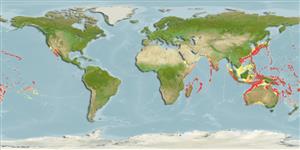Teleostei (teleosts) >
Scombriformes (Mackerels) >
Bramidae (Pomfrets)
Etymology: Taractichthys: Greek, taraktes = confusion; for the pletora of names that have been applied to this fish + Greek, ichthys = fish (Ref. 45335).
More on author: Döderlein.
Environment: milieu / climate zone / depth range / distribution range
Ecology
Marine; benthopelagic; oceanodromous (Ref. 51243); depth range 50 - 700 m (Ref. 58488). Tropical; 40°N - 36°S, 40°E - 110°W
Indo-Pacific and Eastern Central Pacific: East Africa to California, USA. References to Taractichthys longipinnis in the Indo-Pacific are considered misidentifications of this species. Highly migratory species.
Size / Weight / Age
Maturity: Lm ? range ? - ? cm
Max length : 60.0 cm TL male/unsexed; (Ref. 4388); max. published weight: 11.0 kg (Ref. 4388); max. reported age: 8 years (Ref. 4388)
Dorsal
spines
(total): 0;
Dorsal
soft rays
(total): 33-37;
Anal
spines: 0;
Anal
soft rays: 26 - 28;
Vertebrae: 44 - 46. Body covered with large hard scales, each with a spine. Anterior lobes of dorsal and anal fins high, but changing in shape and height with growth; both fins covered with scales, not depressible in a groove. There are no areas without scales above nor behind the eye. Adults without a lateral line. Attains 60 cm SL.
Occurs along the shelf edge (Ref. 11230).
Life cycle and mating behavior
Maturity | Reproduction | Spawning | Eggs | Fecundity | Larvae
Smith, M.M., 1986. Bramidae. p. 633-636. In M.M. Smith and P.C. Heemstra (eds.) Smiths' sea fishes. Springer-Verlag, Berlin. (Ref. 4388)
IUCN Red List Status (Ref. 130435)
Threat to humans
Harmless
Human uses
Fisheries: commercial
More information
ReferencesAquacultureAquaculture profileStrainsGeneticsElectrophoresesHeritabilityDiseasesProcessingNutrientsMass conversion
Tools
Warning: mysqli::__construct(): (HY000/1040): Too many connections in /var/www/html/includes/speciessummary.lib.php on line 2414
Can't connect to MySQL database fbquizv2. Errorcode: Too many connections
